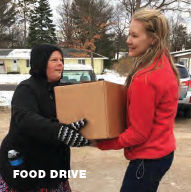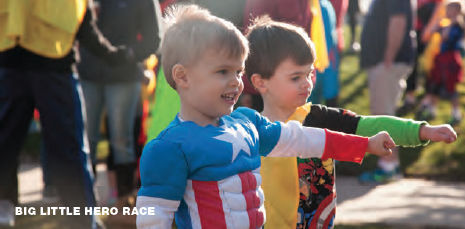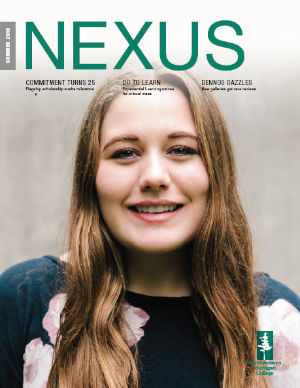Do To Learn
Experiential Learning Flips Classroom Scripts, Advances Across Campus
Nexus Summer 2018 Feature
Voices in headphones clamped over Kami’s pink hair whisper in the 20-year-old’s ears that she’s been chosen. She’s special. She’s the one.
Suddenly, the flattery stops. The voices’ solicitous tone ends. Now through the headphones, the voices tell the NMC psychology student she’s wrong, bad and dirty, adding in obscenities for good measure.
Positive or negative, sometimes not even intelligible, the recorded voices distract Kami from the questions her class partner’s asking simultaneously. Other student pairs call the hearing-voices experience frustrating, confusing, even scary.
Reaching those conclusions themselves is the whole point of the simulation, which students underwent to experience the abnormal psychology they were studying.
“They’ll remember that a lot longer than seeing a (video) clip or hearing me talk about it,” said social sciences instructor Lisa Blackford.
Welcome to Experiential Learning, a high-impact instructional style that until recently existed mostly in pockets at NMC, and typically in applied fields like visual communications and culinary, or health fields like dental assisting or nursing—from whom Blackford borrowed the hearing-voices simulation. But since late 2016, a core group of faculty have been working to take EL to critical mass campus-wide.
Co-chair Kristy McDonald, a business instructor, sums up EL as flipping the “learn to do” instructional style that’s dominated higher education for decades into “do to learn”—skills like teamwork, communication and flexibility. Not only do those skills transfer between job settings, cultivating them benefits students wholistically, as citizens, family members and for other roles they’ll take on in everyday life. Along the EL way, students are engaged and learning is deepened compared to a traditional, lecture-style class.
“Traditionally, education has put the emphasis on content, and skills are very secondary,” said Brandon Everest, a social sciences instructor who co-chairs the EL group with McDonald. Research shows, however, that skewing the approach toward building skills yields better results, especially with first-generation students.
“It changes their investment in learning,” Everest said. “Students want more of it, and teachers who do it want to do it more.”
Blackford is one of those teachers. As a social work instructor, she’s collaborated with Everest and others on EL projects for three years, notably Hunger and Homelessness Awareness Week in November. The success of that led her to experiment with incorporating EL in her psychology class for the first time this past semester. In addition to the hearing voices simulation, her students also visited NMC’s Child Care center to test some of the child development theories covered in class.
 “It motivates me to see the transformation,” Blackford said. “Instead of students just passing through your class and hoping it’s making a difference, I’m very confident it’s changing students’ lives.”
“It motivates me to see the transformation,” Blackford said. “Instead of students just passing through your class and hoping it’s making a difference, I’m very confident it’s changing students’ lives.”
McDonald uses EL in four classes. Her best known are semester-long projects that also benefit the broader community. Over the last five years, regional food pantries have come to rely on an annual fall food drive organized by McDonald’s students to fill up their shelves for the holidays.
The food drive’s spring semester counterpart, the Big Little Hero Race, has raised more than $90,000 for Big Brothers Big Sisters of Northwestern Michigan in just four years. McDonald sees other benefits, too.

"Grades go up. You have no absences," she said. "(Students) stay in touch. They go out together." They might even call their teacher from a downtown restaurant, where a project strategy session wound up.
As Blackford and McDonald’s approaches show, EL can be scaled from an individual assignment to a whole-course syllabus. Online classes can be experiential, too.
In 2017, as Everest and McDonald embarked on their critical mass challenge, they visited Guttman Community College, a branch of the City University of New York founded on principles of experiential learning. NMC’s not far away from what they saw there. The renovation of West Hall into the Innovation Center, which gets underway this summer, will accelerate the adoption of EL, with the flexibly-designed space open 24-7. With a building that doesn’t close, students can keep their project buzz alive and skip the trip downtown.
“Any student coming to NMC will be touched by this high-impact approach to learning,” Everest said.
“We are going to be a leader for EL,” McDonald vowed.
Mailing List Change Requests
To be added to or removed from NMC mailing lists for print publications like Nexus, or to update your mailing address, please send an email with your name, address and request to foundation@nmc.edu, or call (877) 922-1021 or (231) 995-1021.

EL At A Glance
- Students work in teams
- Project-based
- Opportunities to apply knowledge directly
- Often “flipped” classrooms where faculty guide and help rather than impose and instruct
"It’s helped me grow. It really has, just on all levels, professionally and personally.”
– ABBY GUDITH, BUSINESS STUDENT
“You were actually doing something that mattered to the community. You got to see what your results were.”
– KYLE BROWNLEY, NMC BUSINESS STUDENT